Sherts, Trewes, & Hose .iij. :
Chosen Hosen
| Updated 1 Aug 2009 |
by
maistre Emrys Eustace, hight Broom |
|
IAmBroom @ netscape.net |
| The history of medieval hosen is not a view of a continuously improved
product. It involves several nations, and several centuries, and like
all Medieval innovation, its course is slow and uneven, guided more by
habit and tradition than by thought. An apprentice to a tailor was
trained by rote; a medieval tailor of any sort, by what examples we can
find in literature and artwork, would draft an item for a customer
freehand on the cloth, or perhaps rely on a series of master templates.
Modern pattern sizes, in any notation, were an unknown concept in so far
as we can tell. From this remote vantage point, take a look at the
complexity of snugly fitting the garment to the human body (anywhere on
the body!), and you can begin to appreciate the difficulty in attempting
broad innovations in style. A tailor who attempted a radical change in
pattern would have to teach himself by rote how to recreate that new
pattern, or possibly recreate his entire stock of master templates. This
was not an age when people could afford to scrap or replace yards of
specially cut cloth on a whim. Seemingly every time the medievals were
faced with the decision of spending more labor or more material, they
opted for the labor-intensive solutions: clearly, labor was cheaper than
material.
|
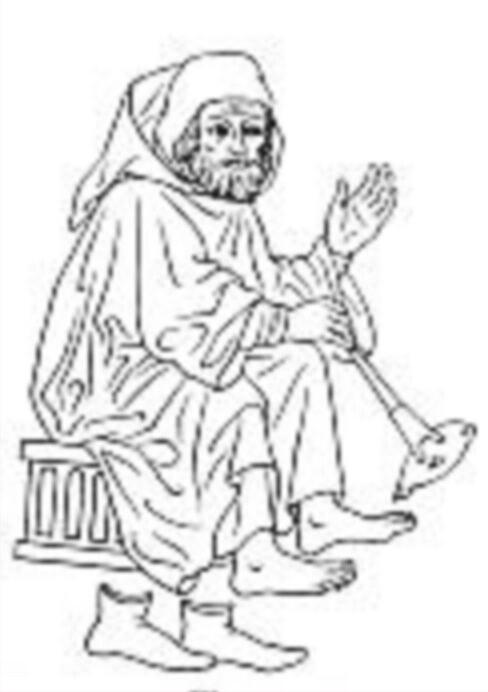
Hoseless old man. Houston p 46
|
By necessity, therefore, any surviving garments were either
likely to be widely used, or at worst, represent repairs to a standard
garment. An exception to this rule might be fantastical show garments, such
as parade armor doublets, that were singular creations for the wealthiest
nobility. And even then, one might expect more innovation in the layer of
icing than the cake itself.
We are going to track the evolution of hosen from knee-length
stockings to the edge of their final fruition as a single garment of joined
hosen, before the Great Advance of knitted stockings (probably at the end of the
sixteenth century).
|
The Problems
Hosen are difficult to make, manufactured of an expensive material
(hand-loomed cloth, throughout most of our period), and uncomfortable to
wear (compared with most of the less fashionable alternatives, like going
nekkid underneath your tunic). What evidence I have seen supports the
logical conclusion that hosen rarely extend higher than is necessary for
warmth (foremost) and decorum (which varies with social class).Men's
hosen are among the most difficult of tailoring problems. To make
'chausses', a specialist called the chausse(u)r developed (a possible origin
of the surname Chaucer). Hosen should ideally fit snugly, for perfectly
practical reasons beyond mere looks (warmth, snagging, economy of material),
and allow unhindered flexure at the heel, knee, and (eventually) hip. Once
they become a single piece (a pair of hosen), they have to cover the rump as
smoothly as possible while standing, although the act of sitting causes a
considerable change in length over the buttocks. And while at first glance
the packaging of the bosom might seem similar to the male packaging problem,
let me absolutely assure you that the male components could never endure the
same sort of reshaping that ladies' bust lines routinely undergo! So, even
while the bum stretches the rear seams to their limits, the fore pouch must
remain stress free. |
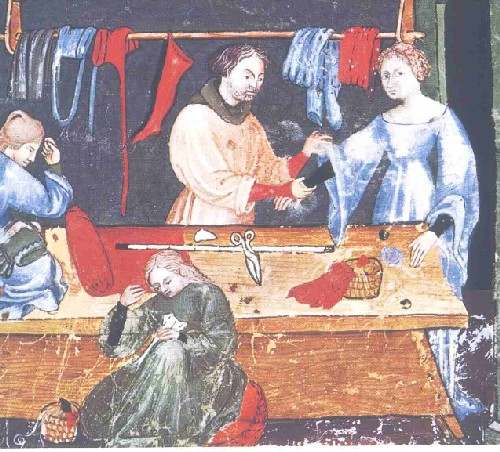
Late 14th c hose & hood shop [Boucher p10]
|
The problems areas facing this design are:
| Foot: |
an improper under seam can hobble the wearer |
| Heel: |
a high-wear portion of the hosen, we can
expect |
| Ankle: |
the heel of the foot still has to fit through
this area, without excessive bagging |
| Calves: |
traditionally a show point of male beauty, the
hosen should fit snugly over this curve |
| Knees: |
bend without bagging |
| Thighs: |
snug without scratching |
| Fork: |
join without splitting, while covering as
closely as possible |
| Buttocks: |
just say "no" to crack! |
| Pouch: |
cover without cramping, and remain easily
accessible for inter-ambulatory ammonia dispersal |
| Material |
Gawd, don't it use up fabric fast! The feet
stick off perpendicular to the leg. The legs are longer than a
typical medieval loom width, and even on the diagonal and
accounting for shorter medieval men, you're really pushing it to
get heel to hip covered in one smooth sweep, once you unfold the
leg piece. |
|
Hosen Colors by Incidence in Artwork
| Red |
180 |
28% |
| Black |
91 |
14% |
| Blue |
73 |
11% |
| Green |
60 |
9% |
| White |
60 |
9% |
| Parti-colored |
46 |
7% |
| Brown |
40 |
6% |
| Grey |
35 |
5% |
| Yellow |
24 |
4% |
| Fuscia |
16 |
2% |
| Tawny |
12 |
2% |
| Beige |
5 |
1% |
| Purple |
4 |
1% |
| Gold* |
3 |
1% |
| Total |
649 |
100% |
* "This has to be an artistic conceit. They were
gilded!" - Baron Morgan de Villarquemada
Compiled by Baron Morgan & Sir Mathias |
|
Hosen Colors
In a discussion forwarded to me from the SCA Laurel list, two
gentles compiled the incidence of hosen colors from a number of sources.
After removing redundancies, the totals are tabulated at right. Thanks are
due to Sir Geoffrey Matthias and Baron Morgan de Villarquemada for these
compilations, and their sources are noted in the bibliography.
The top three colors, red, black, and brown, represent 53% of
the hosen depicted. I assume a bias in the artwork towards disproportionate
depictions of the upper class, who have access to more diverse and costly
dyestuffs, so these three colors might have been even more popular in practice.
Textiles & Clothing (T&C) documents numerous cloth pieces dyed with madder, a
common dye plant that can produce a rich red. Iron-based dyes, such as oak gall,
would dye wool black or brown. Although iron dyes are ultimately corrosive, the
fabric could likely survive the wearer.
Since the Medievals did not seem to attach much erotic
importance to underclothing, there are few "titillation" depictions of these,
even in religious allegories of damnation. Lovers in bed are depicted naked,
except perhaps for nightcaps. The damned in hell are typically portrayed either
nude (naked, defenseless, and stripped of dignity), or wearing the excessively
rich and vain clothes for which they were condemned (exemplifying the mortal sin
of vanitas).
Houston [p 46] shows an old man warming his feet beside a
cooking fire, who is clearly not wearing any hosen. Bare feet in leather shoes
are not terribly comfortable, and even the poor could afford rags for foot
wraps, but this is still a rare view: a medieval man wearing clothes but not
hosen. Since his clothing is not particularly poor, it is possible that he has
removed his (presumably knee-length) hosen to dry, as well. A look at the
primary source might be enlightening.
| Separating Hosen from Red Herrings
The first problem in recreating their hosen is to discern the
difference between the vast quantity of nondocumentable hosen patterns
available to us today, many of which can create good-looking hosen, from
the very few documentable patterns. There are no existing complete and
undamaged medieval hosen. We have a few examples from bog burials,
preserved unevenly (albeit maybe distorted) by the centuries of peat
pickling, and a few (typically more damaged) examples from offal dumps
and elsewhere, as documented in Textiles & Clothing. As an example of
what I consider to be the worst kind of misinformation, we can look in
Kohler, who provides a large number of patterns for costumes throughout
Europe's history. Sometimes, his patterns are probably based on real
garments that he has personally examined. However, in other cases the
patterns seem to be pure conjecture, and there is little distinction
made between the two. Consider the pattern he suggests at the right for
a "fourteenth century hose". Certainly, this pattern does not resemble
any documented item that I am aware of. It is the only purportedly
medieval hosen pattern I know of in which the foot is not composed of
multiple seams, dramatically wasting cloth when laid out—and thus
instantly suspect. Kohler's pattern is also suspect in the
attractiveness of its pattern. Doesn't it just look like a leg? Notice
the well-articulated knee. Admire the curve of the calves. One can
almost draw out the tendons of its owner! Realistically, the item is
made of a stretchy material (wool on the bias), and such details as a
widening at the kneecap are probably neither necessary nor practical.
Gartered or not, there is little guarantee that the kneecap easement
will fall & stay where it is intended. Real medieval hosen case the leg
in a relatively straight-sided pattern. This is not to say that
Kohler's work is without merit, but only that it is seriously lacking in
documentation, and sometimes falls short of providing adequate
descriptions. But, if a pattern works (and there is no proof that his
will, but at least some undocumented patterns will), why not use it?
There's no reason not to. Few will ever know the difference. But save
yourself an hour: this class eschews what will work for what
did work for them. As a final point about recreating hosen,
remember when looking at period depictions that a man's legs are in many
ways the counterpart in sexual display to a woman's bosom, and might
therefore be as idealized. Court dandies and young heroes of virtually
every period are depicted with skintight hosen. |
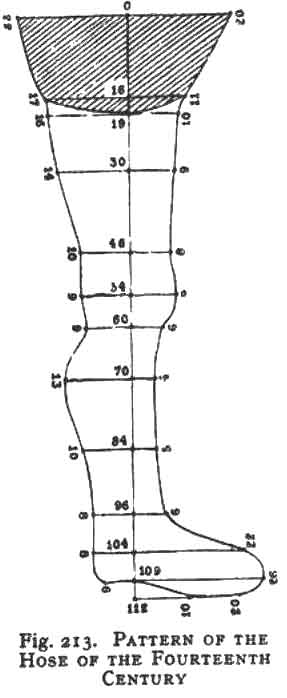
Fanciful "14th century hose pattern". Kohler p 181
|
Children
What evidence I have suggests children mostly went barelegged.
Considering the expense of cutting hosen for a rapidly growing child, this
makes sense. In winter long tunics would keep them as warm as their mothers
were, and in summer no one could be too offended by the harmless, occasional
flash of an 8-yr old willicker. This was an age of public bathing, after
all.
The school-age children mentioned in Sherts, Trewes, & Hose I,
who are depicted running about bare-bummed under their tunics, are also clearly
hoseless.
Women's Hosen
It is rare that a clothed woman is portrayed in medieval
artwork with her feet or legs exposed, beyond /perhaps/ the point of her
toes sticking out of her gown. The exceptions tend to be laborers (and even
in the field, women's legs are often covered to the ankles) and full nudes
(Rebecca caught bathing, for instance). There is a 14th c illustration of a
musician playing something akin to a hurdygurdy, with her ankles & lower
shins visible (gasp!); her two dancing musician girlfriends however have
their ankles fully covered! (The seated musician has parti-colored hosen, by
the way.)
From all of this, we can safely surmise that women's hosen
/might/ never have risen above calf-length (but we can't be sure!!!). Lower, and
they won't stay up. Higher, and they waste material. If the multiple dress
layers (sufficient to keep the body warm) aren't enough to keep the legs warm,
well, young lady, perhaps you ought'n't be lifting your skirt up!
As always, there are also health and hygiene considerations. No
wool on the inner thighs is a good thing, for obvious reasons of comfort, and
doubly so for the lady who might very well own only one pair throughout the
month.
There is proof of this theory that women (usually? only?) wore
short-hosen, in depictions of couples in flagrant delecto. Similarly, since the
ankles are rarely visible, there is little reason to envision a separate styling
for women's and men's hosen below the calf. Also, since garters suffice nicely,
there is little reason to suppose any other method was ever used by women,
rendering what became for men a mostly decorative nicety, an essential part of
the feminine wardrobe. This neatly answers all of the problems from the knees on
up, in fitting the hosen!
Documented Construction Techniques
Cloth
As much as knitting would have benefited the garment, there is
no evidence whatsoever that it was used on hosen (or in fact, for anything
but gloves, hats, mufflers, and baby Jesus' shirts) prior to the gift of
knitted silk stockings to Queen Elizabeth (I).
Warp-weighted looms stretch the naturally springy wool fibers
during weaving, producing a one-way extra stretchiness in the wool. We have no
evidence that this was used for hosen, however.
Most existing cloth believed to be from hosen is bias cut
(diagonal to the warp & weft threads). This would make the warp-weighted cloth
less desirable, since it would only stretch well on one diagonal.
Wool is the cloth of choice for medieval hosen. No other natural
yarn has as much stretch; few breathe as well in the heat while insulating in
the cold; it repels both rain and splashes of mud; it dyes easily to a rich hue;
and finally it cushions the foot within the shoe.
A fourteenth-century charter of the chausser's guild requires
that all hosen be cut from scarlach. Scarlach is a fine wool, made by raising
the nap and shearing it away at least three times (according to one source). The
result would be a very fine finish that obscured the individual threads of the
cloth. The most popular color for these scarlach hosen was red; this is the
origin of the word "scarlet".
Lining & Reinforcement
That hosen were frequently lined, we can document. In a post
to H-Costume by Brenda Brisbane, dated 10 Oct 95:
"From a Guild charter from Spain in the 15th C in Hispanic
Costume 1480 - 1530, ISBN 87535-126-3, all hosen made by guild members
must be lined with new linen, and the waist area adequately reinforced with
canvas. Also, inventories in [Queen Elizabeth's Closet Revealed, by
Janet Arnold] list linen stocking liners.
As pictorial evidence, a manuscript illustrating the Romance
of the Rose [Bod. Lib] depicts a poor man wearing dark hosen from the last
quarter of the 15th c. One of his points has broken or is untied, and the
tip of the hose hangs down, exposing a white underside—clearly lined with a
different material.
I can personally attest that woolen hose made of soft wool are
not nearly as scratchy as they sound; I quickly forget them after putting them
on. However, the linen stocking liners are an obvious improvement, even though
they complicate the construction. Linen has very little stretch compared to
wool, and therefore must be cut baggier; but this might create bagging material
under the wool (a sort of medieval panty line), for which we don't see any
pictorial evidence.
Lady Kate Oakley has made woolen joined hosen for her husband
from a 14th c pattern, and lined only the trunks and upper thighs of the hosen
with linen. This allowed her to provide comfort and snug fit along the legs,
with the benefit of being more economical of fabric. It is perfectly plausible
that this is what was meant by the references to linen linings. I have a pair of
modern dress pants lined in exactly the same way (except their lower edges are
pinked, whereas Lady Kate used the selvedge); is everything old new again?
Stitches
The example stitch at right is only known to have been used in one
place: the underfoot seams on hosen. It offers the minimal possible
unevenness beneath the sensitive sole of the foot possible, aside from
butt-joint stitches (which are presumably too weak). I tried to make
hosen with a standard turned seam (such as is used on most modern
garment seams); the slight ridge this produced across my arches nearly
lamed me within the first hour of walking in the grass!
Otherwise, seams are probably sewn with lapped seams, which present a
smoother surface than turned seams. We can document single hems at the
tops of hosen with a simple running stitch; double hemmed edges are rare
in any surviving garments.
General Pattern Structure
Every single documented hose pattern has a one-piece leg with a back
seam. Almost all are cut on the bias; those cut on the grain of the
fabric are only knee-high. In all cases the quarters of the foot (sides
& back of the heel) are cut as part of the leg piece. Most have separate
vamp pieces (vamps cover the portion of the foot ahead of the leg).
Those that do not, have a tongue-like extension covering the top of the
foot, which may wrap around to the bottom, or meet a sole that wraps
upwards. Most place a seam along the length of the sole. One later
pattern has extra, triangular pieces to improve the fit around the
junction of the foot to the leg.
|
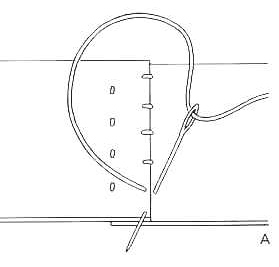
Stitch found only (so far) on hosen underfoot seams. T&C p143
|
|
Holdups
There are four basic methods of documentable hosen support:
garters (which only suffice when the hosen are knee-length), pinning to the
trewes' thighs, one-point ties (per hose) to the trewes' cinch cord, and
tying through the jupon.
Garters & Ties
The Anglo-Saxons cross-gartered, of course; this refers to a
practice of wrapping the (loosely fitting) hosen tightly to the legs with a
crisscrossing band of ribbon. Labourers continue this practice for a long
time past the Conquest, as a practical method of controlling their baggy
hosen. While tunic styles were long (basically until the 14th c), the hosen
could be gartered at the knees. Simple drawstrings also have served this
purpose, as in the early hose (attributed to St. Germain) at the right.
After the rise of the hemlines, of course, garters continued
to serve a purpose keeping hosen snug just below the knees, making them less
likely to snag, and emphasizing the curve of the calves.
Woven cloth garters from the 14th c have been found in
London excavations [T&C p143-4]. Scraps of cloth were also pressed into
service as garters; T&C [p104] documents a twill unhemmed band tied
forevermore as a garter. Occasional drawings suggest bejeweled or otherwise
decorated garters; these might have been made of leather, but I am not aware
of any firm archaeological evidence. The famous badge of the Order of the
Garter appears in its earliest depictions (ca. Edward III) to be a leather
garter with buckle and buckle piercings.
|
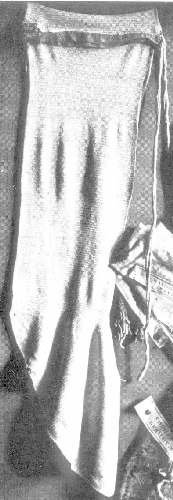
600s,"St Germain's hose". Boucher p 159
|
Brooches
The wonderful people at Gaukeler's Medieval Wares alerted me
to the discovery at the Battle of Wisby gravesite, where masses of soldiers
were buried in full armor immediately after the battle out of fear of the
plague. Multitudes of corpses, from whom the clothing had long since rotted
off, had annular brooches fused to their thighbones (as opposed to a
penannular brooch, these are a complete circle). Apparently, the cloth of
both the trewes & the top of the hosen were drawn through the ring far
enough to slide over the brooch pin tip, thus pinning them together.
|
The fellow in the picture at right, from the Luttrell Psalter
(vaguely contemporary), may be using this method. Although the depiction
looks more like a button, it seems likely (and another gentle's
experience bears this out) that a button would shear off or rip out, no
matter how strong its shank.
The downsides to this method include damage to the undergarment
(linen), and to a lesser degree the hosen themselves from the pin. Holes
could be preset in the garments, but finding these holes with the pins
might prove cumbersome. Additionally, this method will only work while
the tunic stays well below the fork, as the highest point of the hosen
can only be thigh-high. Brooches on the hips would show through
unattractively.
Points: Mo' Better…
Points, or attachment cords, begin their history as unadorned cords.
T&C documents several different cord patterns that the medievals made
from yarn. Most require only the simplest of specialized tools, such as
a lucet harp, and string was so universally useful (then as now) that
almost every woman no doubt spent countless hours of her life at this
easy task. Compared with threshing grain or fine needlework, it may have
seemed restful. The expense of leather, and relative ease with which
cord can be made, suggest that leather thongs were probably not used for
this purpose. Again, they tended to favor labor over material expense.
Cloth scraps cut on the bias would also serve the purpose; I've used a
single bias-cut strip of unhemmed cotton for years to hold up my trewes
with no embarrassing failures to date. |
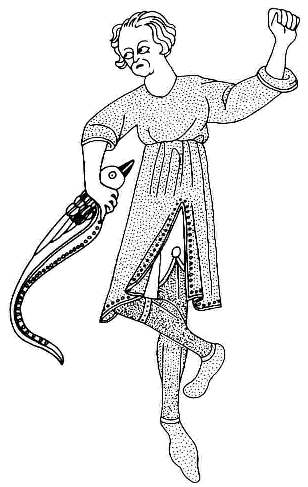
1325-35. Luttrell Psalter, hosen w 'button' & garter. T&C p 187
|
|
For the majority of the medieval period, and after the hosen rose too
high for garters & pins, one point sufficed. As late as the mid-15th c,
we find evidence of single hosen held up this way, with trewes that make
today's "briefs" look like a bodysuit. The points are placed at the
point of the hips, and seem to be a cord that loops through a single
hole (probably reinforced like a buttonhole) on the hosen. This ties off
on the waist cord of the trewes, which sometimes have a pair of slots
cut in the waistband channel for this purpose. The single point is just
forward (inside) of the point of the hip, where no bodily movement will
ever require it to stretch, it is maximally accessible to the wearer,
and the most visible side of the garment thus rises highest (wearers
looked their best from the front view). Despite this popularity, the
thigh line will sag, and to truly achieve that proper look of continuous
color, more support is needed. The next logical place for support was,
and is (on modern women's hose), at the sides. This is spot changes
least in length when the body bends at the waist. The front points'
distance shortens, but that is forgivable. To space the next points out
more evenly would lay them over the haunches, which increase
dramatically in line length when sitting. As sensible as this
progression may seem, I've never yet seen medieval hosen designed to be
held up by only two points, that take advantage of this next, best
tie-off spot. |
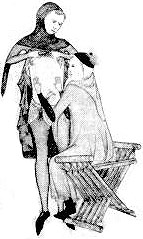
14th c doctor & patient. Cantor p328
|
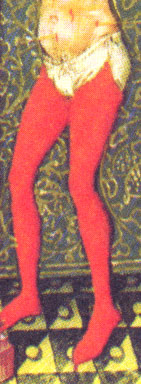
1440. From Hours of Catherine of Cleves
|
|
One great disadvantage in tying hosen to the trewes, which themselves
are cinched below the point of the hips, is that it limits the hosen to
lay below even that point. This makes it impossible for the hosen to
completely cover the buttocks, so haut couture could not put a man's
midsection on display until a solution was found. A second
disadvantage is that the stress of the hanging and tugging of the hosen
wears on the hips; again, the analogy between men's hosen and women's
bras seems apropos..
Jupon Points: Break On Through To The Other Side
The solution was found long before hemlines dared raise above the
fork. The points were threaded through pairs of holes piercing a sturdy
undergarment, called variously the jupon, gypon, and eventually the
doublet (of 'doubled' material). This garment lay over the shirt and
trewes, but was probably initially covered by an outer garment such as a
cotehardie. Many authors have written with great authority in their
voices about how this garment was padded, sculpted to form the pigeon
breast popular in 14th c paintings of dandies, and so on; but I have
looked in vain for evidence to back up these assertions. Military
jackets are padded for safety and armor comfort; that covers the Charles
de Blois and Black Prince jupons. There are occasional references in
15th c accounts to purchases of bombast (wool or cotton wadding) for
clothing, but it is unclear how much of this was intended for military
garments. |
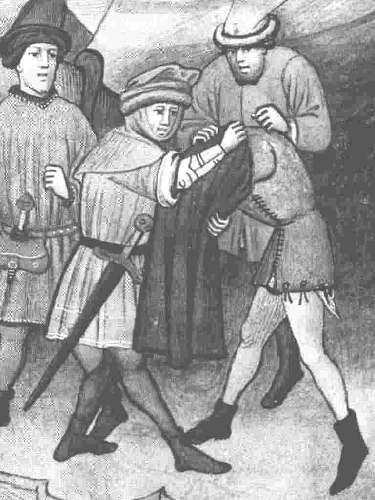
1430-40. Bocaccio's Decameron. Tarrant p 17
|
This redistributed the stress of the hose to the entire body
(since the jupon was a closely fitted garment), and guaranteed a continuous
surface of intentionally displayed clothing from toe to chin (since high
collars were in vogue). The downside is still those damned buttocks: even
though the hosen now essentially tie (via the jupon) to the shoulders,
sitting produces a tremendous increase in line, and stooping even more so.
|
The points, therefore, show up in the same places as before
(for the same reasons). A new pair of points appears at the center back—one
pair for points from both hosen (now joined). This stress line goes down the
center of the buttocks, which allows the tights to tighten into the crevice
during bending—turning a disadvantage into a display opportunity!
Nonetheless, deep bends still demand more increase than the material could
reasonably be hoped to endure, and so we constantly see laboring men leaving
these points untied, even clearly tradesmen and mercenaries. But the option
to 'tighten up' before stepping out is now available.
Variations on the Theme
Footless Hose And Foot Wraps
|
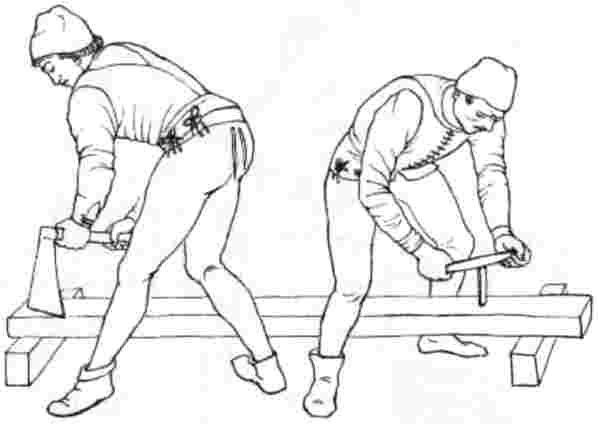
1450-60. Hosen points attached to doublets, and untied in back for ease
while working. Houston p 181
|
I will be as brief as my knowledge on this topic. Foot wraps
have been reportedly found to be used. They were probably made of rags.
Certainly, they make the issue of shoe fit simpler, and add cushion and
insulation to leather soles & uppers. Pictorial examples of stirrup-style
hosen are somewhat uncommon, although there are some of fools (tumbling;
presumably the bare feet were for safety), and occasional others, such as
the depiction in Froissart's Chronicles (c1425) of the execution of of
Pierre and Alain Roux. Some of these stirrup hosen were on military men;
these might have been more practical to maintain on campaign. There are
drawings of the poor with the feet worn off their hosen, of course, but I
believe that most period hosen were designed with full feet, despite all the
complications in design & cloth that it costs. Regardless, a hose foot
seamed onto the legs is more economical than separate socks.
Joined Hosen
Late-14th c fashions for dandies raised the hemlines to the
ballocks, and early 15th c saw the first public exposure of the male crotch
beneath the tunic. This trend forced the chaussers to invent the one-piece
or joined hose. There is a turn-of-the-century admonition by an English
bishop against men who sit splay-legged, exposing themselves; the
implication is that they have purposefully chosen to omit wearing braies for
shock value, but it may merely indicate outrage at the public display of the
underpants. By this point or soon after, the joined hose are no longer tied
to the waistband, as mentioned above.
It should be noted that the rise of joined hosen did not
eradicate the older, simpler style of separate hosen. As late as 1460 there is
clear evidence in manuscripts of separate hosen worn by a member of the middle
class. Obviously joined hosen, with the difficulties in tailoring and
susceptability to bursting at the seat seams, were unpractical for the laboring
class altogether.
Soled Hosen
There was a late 14th c innovation in hosen which added a
leather sole. Since the sole was comparatively stiff, it did not shift
around on the foot. These soled hosen were worn without shoes (the sole
serving that purpose), and worn outside with pattens (wooden platform
sandals or clogs, occasionally made with leather hinges to allow them to
flex at the ball of the foot). The pattens were not exclusively worn with
soled hose; they protected the expensively tooled or low-cut shoes of the
well-to-do from the filth and mud in the streets. Since pattens were simple
to make, they might have been very common. Nonetheless, Shoes and Pattens
documents a few different finds. Some of these were shaped with lengthened
toes to protect the long toes of the hose or shoes, which were popular in
England into at least the first quarter of the 15th c.
Because soled hosen are an intrinsically delicate form of
footwear, their use was restricted to (male) dandies. They invariably display
long pointed toes, therefore. Their visual effect is to blur the distinction
between foot and leg. In an age where long, slender limbs were regularly
portrayed in art as the ideal of male beauty, these might have made the legs
appear longer (especially with the pointed toes).
Soled hosen do not appear until around the invention of the
single, joined hosen. Since they are a highly impractical haute couture, it
seems likely that they only occurred as joined hosen, as they appear in all
depictions I have seen.
Codpieces
|
The famous codpiece probably began in the 15th c as a mere
flap covering the front (open) seam of the joined hose. The padding might
have started out merely as a prudent innovation to protect future
prospective generations from chill drafts (since the tunic now offered no
protection). It is the mid-16th c before we see any appreciable sculptures
erected upon this plain base; for over a century they were content to merely
display the region with no more than a color boundary for advertisement.
Nonetheless, here we finally begin to see the beginning of a generally
erotic perception of underclothes, instead of a purely utilitarian one.
Note that the codpiece was a functional flap. It
could be dropped open at will, for ultimately every male garment must
accommodate the unerring drive of men to PSU - Pee Standing Up!
Buskins Or Leg wraps
Buskins are defined here as short, heavy hosen, tied just above or
below the knee, and often worn over normal hosen. These are typically
worn to protect the hose & legs from brush, and are seen used by
horsemen, huntsmen, etc. Houston [p35] mentions buskins as liturgical
vestments: "These are really stockings, originally of linen, later of
silk or velvet. When embroidered the pattern was generally of an
all-over design [p70]. Embroidery… is from the center front of a
buskin.… They ended at the knee where they were tied with a ribbon."
Civilian buskins were similar, minus the embroidered decoration (at
least, in every depiction I have ever found). Buskins may occasionally
be made of leather, according to some sources; this makes sense for
protecting the calves of hunters riding through the forests, as depicted
in Gaston Phebes' The Hunting Book. |
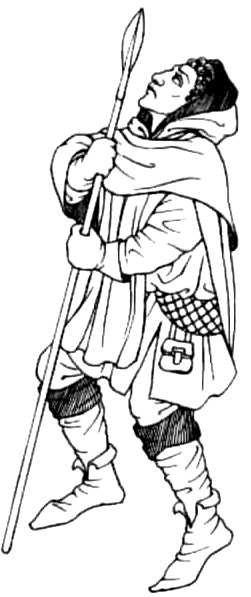
c1450. French hunter wearing (2 pair?) short hosen or buskins. Houston p
170
|
Cutting Hosen From History
The patterns on the previous page represent many of the known,
surviving 'reconstructable' period hosen. All are taken from Marc Carlson's
wonderful web pages on medieval garments.
There are unfortunately no surviving examples of medieval
joined hosen at all. Yes, there are several examples from the Renaissance,
but that is outside of the specific scope of this class (and would fill a class
unto themselves).
The first is actually described as trousers, but in many ways,
it is a pair of joined hosen. Notice that at this early date, when "Ttunics"
were commonplace ("Armscye? You don't need no stinking armscye!"), the fork was
already defined with a modern "J" curve—because it has to be. Make one
pair of pants without allowing for this expansion curve, or at least a diamond
gusset, and someone is going to be both hobbled and singing à castrati.
An excess of material provides lateral easement in the seat, and angling the
beltline upwards from the center seam provides vertical easement. These
techniques are still used in pants today.
The Bocksten hosen were actually cut on the grain,
instead of the bias, as were the Herjolfsnes #91 hosen and the early St. Germain
hosen. These could not have been close fitting, but they were certainly easier
to tailor (one size fits many). Probably, for the poorest of people, the risk of
miscutting the hosen outweighed the slight savings of tightly trimming the
fabric. Since these were short (kneehigh), perhaps a close fit was still
achievable (although there would be bag at the ankles).
The bizarre suspension method on the Bocksten hosen apparently
tries to create lateral tension at the top of the hose, to keep them from
sagging from the single suspension point. Marc Carlson tried to recreate this,
but hasn't figured the trick out yet, and I haven't even attempted it. Students
are welcomed to investigate and report back!
Hard-Won Experience
Sizing To Fit
We don't have time to apprentice to a master chausser these
days. Cheat the learning ramp by starting with a duct tape pattern, laid over
paper towel wrapping, bridal path paper, or muslin.
I no longer recommend covering the feet with socks, as they
tend to shrink the pattern as soon as it is cut free of the ankle and foot
(and this is the most critical area of the pattern). Instead, wrap the foot in
swaths of paper or cloth, tape them lightly in place, and begin with a duct
tape sole. Then, with the model standing evenly, finish taping the top of the
foot and ankle.
When taping, keep the tape pressed flat, using lengths that
cover little more than half the circumference, as the finished tape monster
will try to shrink up at every wrinkle. Avoid pulling tightly on the
stretchable tape. Bear in mind that compressing the flesh may ask too much
stretch from the cloth. Even though the finished product will be cut on the
bias, there is a limited distance on the circumference to stretch. Immediately
transfer the cut pattern to paper, to minimize tape monster shrinkage.
It Is Very Important…
that you measure the diagonal circumference of your heel, with
your foot extended. This is the least circumference that you can have in the
ankle area. Be very careful to trim no closer than this, despite the bagging
that may ensue. If the material affords a bit more stretch, cautiously reduce
the pattern with stitches during fitting, but don't ever start off with less
than the heel circumference.
Tying To Trewes
Marc Carlson notes, in his web pages on trewes &
underclothing, that medieval (under)trewes always appear to be cinched below
the point of the hips, on the slight gap created between the hip points and
the swell of the thigh muscle. Fat compresses far more than muscle, so even
the lucky rich merchant might have a bit of a gap to hold his britches up at
this spot. Moreover, he notes that this method spreads out the force of the
hosen tugging downwards; a comfort issue that had long beleaguered and
bewildered me. Instead of the whole force resting on the points of the hips
(and the poor skin trapped between!), the force is spread out over the top
of the quadriceps.
Trewes depictions suggest to me that the casing around the cinch
cord may be commonly be padded with multiple layers of cloth. This would help
the strain problem. Some cinch cords seem wider than mere cord, so bias cut
cloth strips may have been used, which would also help.
Snugness
Like a pert bosom, it's just not going to stay that way. The
same fiber stretchiness that allows the wool to snug up to the calves in the
morning allows them to droop about the knees at night. The good news is that
a good wash and dry will retighten them nicely. And the hosen that seem to
have shrunk too much in the wash will no doubt stretch out to a more
comfortable fit as the day wears on, provided that they fit before the wash.
It's not Lycra, but it's not cotton, either.
Washing Hosen
Do—in the washer. Use soap, and cold water. The process that
you will set in motion is called "fulling": the act of converting woven
cloth into a feltlike material (which is why clothing tags advise "dry clean
only"). This fulled cloth will be more resistant to snagging, will shrink
back to unsagged dimensions, and will generally exhibit more of those
wonderful "woollish" properties: water resistance, insulation from heat and
cold, cushioning of the feet. Anytime that the hosen seem especially
stretched out, resort to a warm water wash instead.
And, need I say, wash the cloth in warm water before
cutting? Prewash your wool to pre-full it, so it doesn't shrink too far, and to
remove excess dye. The more you wash it, the more it will full; the wool will
get thicker (while shortening in area). Stop when you are satisfied, but wash
it at least once in warm, soapy water.
Lining
If they're going to be thigh-high, I'd recommend you line them
with linen. Hey, they did it. And following Kate Oakley's "trunk & thighs
only" example, it's not difficult, expensive in material, nor an
unflattering fit. I've worn unlined hosen for years, and yet in the mornings
even I notice a bit of scratchiness.
I recommend linen lining over cotton, because linen doesn't
shrink as much nor absorb as much moisture. This will keep them dry & comfy on
dewy Pennsic mornings, and give them a longer life (cotton garments that don't
dry well deteriorate from rot). Use the selvage for the bottom edges, or at most
a single hem turned towards the hose material, to minimize the transition line.
Wear & Tear
The heels and balls of the feet are going to wear out first,
just like on a shoe. The edges and backs of the calves seem to snag the
easiest, mostly on splinters from wooden seats. Light briar and brush doesn't
seem to bother them much, so the fact that even peasants wore wool hosen makes
more sense now.
Hip-High Unjoined Hose
It's pretty easy, right? Two separate hosen; cinch them up to
the belt; presto! the legs are covered. Except…
The suspension lines are more complicated than that.
Unfailingly, the top edges of the hosen droop ungainly away from the thighs, and
sag unseemly low. The "Bocksten hosen" have a strange attachment method that is
apparently intended to overcome this, by creating some lateral tension at the
top of the hosen. Marc couldn't figure out how it works, and I haven't tried. It
must have worked, because they did it (unless we're completely missing the point
of it); perhaps it wasn't a great solution, however.
Expect unjoined hosen to sag at the thighs. Unjoined hosen were
worn even as late as the 15th c, at least by some, and by then the trewes were
so brief that they couldn't help but show bare leg when they bent over. They do
that.
Bibliography
Anderson , Ruth M. Hispanic Costume 1480 - 1530, ISBN
87535-126-3
Boucher, François. 20,000 Years of Fashion. The History of
Costume and Personal Adornment (Expanded Edition). (Harry N. Abrams, Inc.,
NY 1983). ISBN 0-8109-1693-2.
Cowgill, J.; M. de Neergard; and N. Griffiths. Knives and
Scabbards (Medieval Finds from Excavations in London:1). (HMSO, London
1987)
Crowfoot, Elisabeth; Frances Pritchard, and Kay Staniland. Textiles
and Clothing, c.1150-c.1450. (Medieval Finds from Excavations in London:
4) (alias "T&C") (London: HMSO, 1992).
Disney, Walt. Walt Disney's Snow White and the Seven Dwarves.
(Western Publishing Company, Inc, Racine WI 1994).
Houston, Mary G. Medieval Costume in England and France,
The 13th, 14th and 15th Centuries (Dover Publications, NY, 1996; 1st pub.
Adam & Charles Black, London, 1939, as Vol. II of "A Technical
History of Costume")
Kohler, Karl. A History of Costume. ISBN 0-4862-1030-8.
Nockert, Margareta. "The Bocksten Man's Costume", Textile
History, 18 (2), 1987 and Margareta Nockert. Bockstenmannen, Och Hans
Dräkt. Halmstad och Varberg: Stiftelsen Hallands länsmuseer, 1985.
Nörlund, Poul. "Buried Norsemen at Herjolfsnes: an
archaeological and historical study." Meddelelser om Gronland: Udgivne af
Kommissionen for ledelsen af de geologiske og geogrfiske undersogelser i
Gronland. Bind LXVII. Kobenhavn: C.A. Reitzel, 1924. Drawing after Lundwall
(in Nörlund ).
As discussed in I. Marc Carlson. "Some Clothing of the
Middle Ages" (see Webliography). Copyright 1999.
A study of clothing used as burial shrouds in Herjolfsnes,
Greenland, probably from the late 14th or very early 15th c. The clothing
styles appear to loosely follow those on the continent, despite the isolation.
Tarrant, Naomi. The Development of Costume (National
Museums of Scotland, Edinburgh, w/ Routledge, London, 1994)
Waugh, Norah. The Cut of Men's Clothes, 1600-1900 (Routledge,
Theatre Art Books, NY; 1st publ. Theatre Art Books, GB, 1964)
Willett, C., & Phillis Cunnington. The History of
Underclothes (Dover Publications, 1992; 1st publ. Michael Joseph Ltd.,
London 1951)
Webliography
Bibliothèque Nationale de France. One of the greatest
repositories of medieval images for research purposes, as evidenced by nearly
every costume book I've ever opened. Also, a very friendly institution to deal
with; I thank them for permission to freely use their images for
non-commercial educational purposes. The website, unfortunately, does not yet
carry as much content as the Bodleian.
http://www.bnf.fr/site_bnf_eng/index.html
1,000 Illuminations from the Department of Manuscripts (pages in
English):
http://www.bnf.fr/enluminures/aaccueil.shtm
Bodleian Library, Oxford University. The Bodleian site contains
several of its manuscripts in high resolution, full-page images. Be sure of
which page of which manuscript you want, as the images behind the microscopic
thumbnails are often 3 Mb. However, the grain of the pages can almost be seen in
the shots!
http://www.bodley.ox.ac.uk/dept/scwmss/wmss/medieval/browse.htm#11th .
Schoolboy whipped by teacher (small size):
http://www.bodley.ox.ac.uk/imacat/img0003.jpg
H-Costume (Historic Costuming List). A highly informed list of
worldwide historical costume enthusiasts, with topics ranging from prehistoric
clothing finds to 1970's disco wear. Warning: The digest version alone can be
50kb per day.
To subscribe, send email to majordomo@indra.com, and in the body
of the message, put "subscribe h-costume" or "subscribe h-costume-digest".
http://mail.indra.com/mailman/listinfo/h-costume
With special thanks to:
He provides a website with detailed instructions on how to fit
& construct hosen, and some relevant period illustrations.
http://www.randyasplund.com/browse/medieval/chausse1.html
Carlson, I. Marc (Diarmaid O'Duinn / Diarmuit Ui Dhuinn).
Footwear of the Middle Ages. Copyright 1999.
I cannot too strongly recommend his websites on period clothing finds, shoes,
and related commentaries.
http://www.personal.utulsa.edu/~marc-carlson/cloth/bockhome.html
Hosen color research:
Larsen, Matt (Sir Geoffrey Matthias), sources: "Manuscript Painting at the Court
of France; Sforza Hours; Lutrell Psalter; King Rene's Book of the Tourney
(excerpts); The Bedford Hours; German Paintings of the 15th c.; Museum of
Ancient Art, Brussles; Northern Renaissance Art; Early Flemish Painting; Giotto
to Durer: Early Renaissance Painting in the National Gallery; Other (some
calendars and a few books that had one or two plates)."
and: Steven Proctor (Baron Morgan de Villarquemada), sources:
"The Visconti Hours; The Belles Heures; The Tres Riche Heures; The Rohan Hours;
La Livre de La Chasse; The Golden Age of French Manuscript Painting; Painted
Prayers."
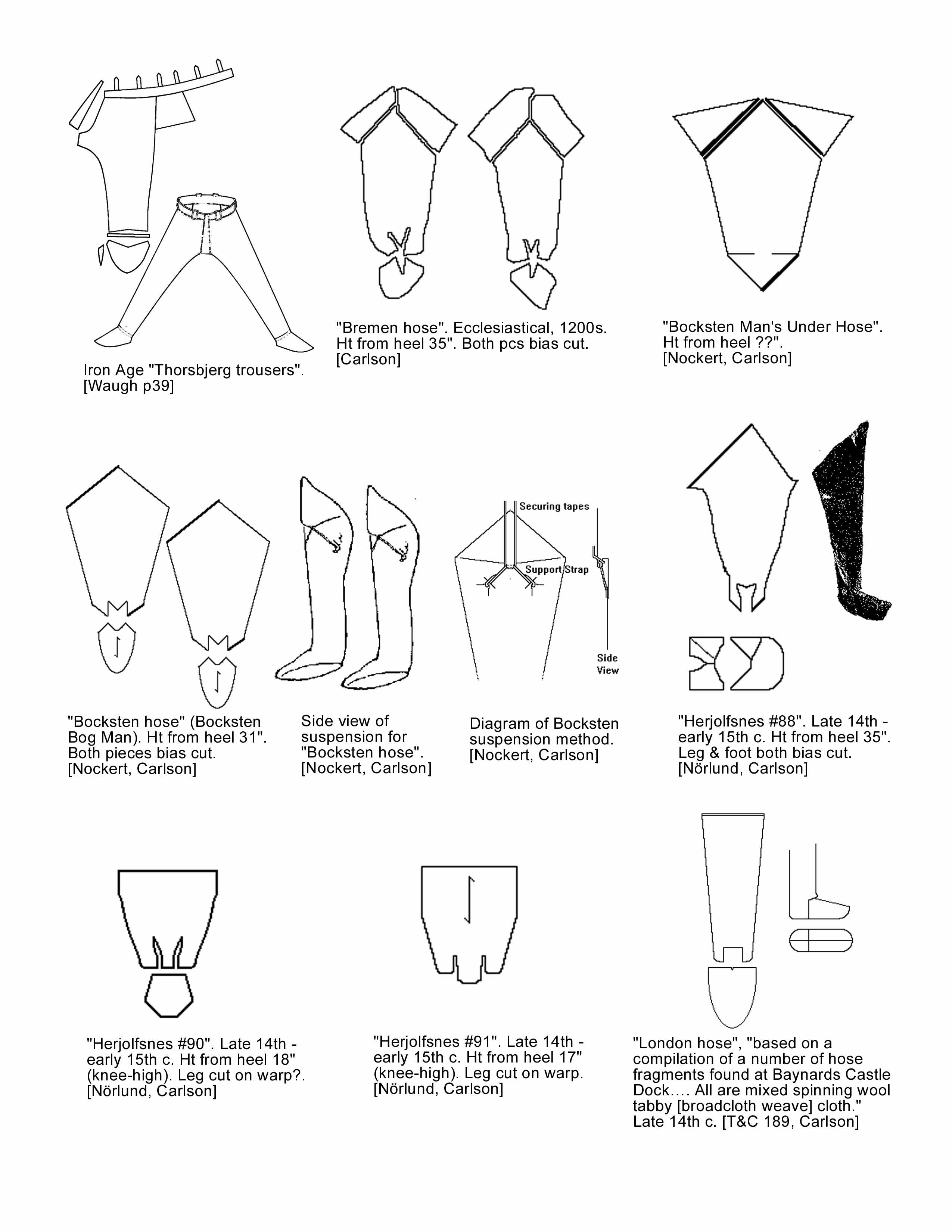

Return to the Greydragon library








